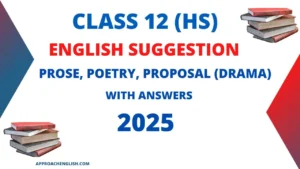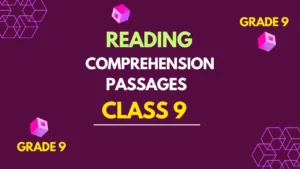The Present Tense for Class 7: Examples and Worksheets for Class 7 is a complete guide to learning present tenses. It has easy explanations, different examples, and fun worksheets to help you understand better in this article. This is perfect for Class 7 students who want to improve their grammar skills.
The present tense in English describes actions or states occurring now or regularly. There are four main types of present tense:
1. Simple Present Tense: Describes habitual actions, general truths, and fixed arrangements (e.g., “She walks to school every day”).
2. Present Continuous Tense: Indicates actions happening right now or temporary situations (e.g., “He is studying for his exams”)
3. Present Perfect Tense: Describes actions that occurred at an unspecified time in the past and are relevant now (e.g., “She has finished her homework”).
4. Present Perfect Continuous Tense: Refers to actions that began in the past and continue into the present (e.g., “They have been playing for two hours”).
The Simple Present Tense for Class 7
We use the simple present tense to talk about
1. habitual actions or routines.
For example,
- He runs a marathon twice a year.
- She always speaks the truth.
- They never stay up late at night.
2. general truths.
For example,
- The sun rises in the east.
- The human body has 206 bones.
- They live in London.
3. something that is true in the present.
For example,
- I am thirteen years old.
- She works in a bank.
- It is a pleasant morning.
4. for future events that are fixed or part of a timetable.
For example,
- The train leaves at 6:00 a.m.
- The flight is rescheduled for tomorrow evening.
- Our school reopens on 25 June.
5. headlines of an article or news item.
For example,
- President Arrives Tomorrow
- Oil Prices Go Up
6. dramatic description of events.
For example,
The film is full of humour. Every time we watch it, it keeps us laughing for a
full three hours. All the characters are funny.
7. verbs which express state, possession, feelings.
For example,
- The flower smells sweet.
- I love my mother.
- She likes music.
- I appreciate your effort.
Simple Present Tense Structures
| Affirmative | Negative | Interrogative |
| I play. | I do not play. | Do I play? |
| You play. | You do not play. | Do you play? |
| He plays. | He does not play. | Does he play? |
| She plays | She does not play. | Does she play? |
| It plays. | It does not play. | Does it play? |
| We play. | We do not play. | Do we play? |
| They play, | They do not play. | Do they play? |
The Present Continuous Tense for Class 7
We use the present continuous tense to talk about
1. actions going on at the time of speaking.
For example,
- I am doing my homework.
- The plumber is mending the leaking sink.
2. short-lived temporary actions. [Now, at this moment, always, at Present]
For example,
- I am reading a novel by Premchand these days.
- She is preparing for her exams nowadays.
3. definite future plans.
For example,
.
- I am meeting my friend this weekend.
- She is going to Greece this month.
- My father broke his leg. So he is working from home this month.
4. frequently repeated actions with ‘always’, ‘continually’, and ‘constantly’ to express
annoyance or criticism.
For example,
- You are always complaining.
- The twins are constantly arguing.
5. trends.
For example,
- More and more people are turning to yoga.
- Raj is growing taller by the day.
6. temporary actions.
For example,
- Fiona is working at St. Andrew’s school for a year.
- Leela is staying with her aunt for a week.
Present Continuous Tense Structures
| Affirmative | Negative | Interrogative |
| I am playing. | I am not playing. | Am I playing? |
| You are playing. | You are not playing. | Are you playing? |
| He is playing. | He is not playing. | Is he playing? |
| She is playing | She is not playing. | Is she playing? |
| It is playing. | It is not playing. | Is it playing? |
| We are playing. | We are not playing. | Are we playing? |
| They are playing. | They are not playing. | Are they playing? |
Comparison: Simple Present Tense and Present Continuous Tense
The simple present tense helps us talk about a habitual action. The present continuous tense helps us talk about an action taking place at the time of speaking.
For example,
- Kiara waters the plants every morning. (habitual action)
- Kiara is watering the plants now. (Action going on at the time of speaking.)
We use words like ‘always’, ‘never’, ‘usually’, ‘often’, ‘sometimes’, ‘every day’, etc. with the simple present tense. We use words like ‘now’, ‘today’, etc. with the present continuous tense.
For example,
- Do you usually go to school by bus? (Simple present)
- Are you going to school by bus today? (Present continuous)
State Verbs
State Verbs are verbs that do not usually have a continuous form. These include
1. verbs of the senses like feel, hear, see, smell, taste. Can and could are often used with these words.
For example,
- Please come nearer. I can’t see you.
- We can smell the roses from the other end of the room.
2. verbs of feelings and emotions: feel, want, desire, like, dislike, fear, love, hate, care, wish, respect, appreciate.
For example,
- Mum hates petunias.
- My sister cares greatly for stray dogs.
3. verbs of mental states and activity: agree, disagree, believe, disbelieve, differ, doubt, find, forget, imagine, know, mean, recollect, remember, suppose, think, trust, understand, etc.
For example,
- I recollect there were three people at home that day. (NOT I am recollecting…)
- I think this is a great idea! (NOT I am thinking…)
4. verbs showing possession: belong, own, possess.
For example,
- She belongs to the ancient Sen family. (NOT She is belonging…)
5. verbs like seem, appear, cost, consist, contain, resemble.
For example,
- This film contains scenes from my native village. (NOT This film is containing…)
- This book costs two hundred and fifty rupees. (NOT This book is costing…)
Some state verbs have both simple and continuous forms. But the meanings of the same verb in these two contexts is different.
| State Verb | Action Verb |
| 1. The dal tastes bitter. (taste) 2. Sophie thinks she can see a UFO every (believes) 3. Your forehead feels warm. You have a fever. (temperature) 4. Mona has three beautiful kaftans. (possesses) 5. Don’t you see how hopeless the situation is? (understand) 6. The curry smells delicious. (aroma) 7. Rohit really enjoys his coffee. (likes) 8. It looks like they are going to be really late today. (appears) | 1. Mum is tasting, the dal for salt, (testing) 2. She’s thinking about quitting her job.night.(considering) 3. Mum is feeling Ronnie’s forehead to check if he has fever. (touch to feed) 4. Mona’s having her dinner early tonight. (eating) 5. We are seeing the Malhotras this evening, (meeting) 6. Mita is smelling the curry. (sniffing at) 7. The kids are really enjoying The Lion King (like)8. Sara is looking out of the window. (observing) |
The Present Perfect Tense for Class 7
We use the present perfect tense to talk about
1. recently completed actions, the results of which are visible in the present time.
For example,
- He has shaved off his beard.
- Suparna has written the letter.
2. personal experiences or changes.
For example,
- Supriya has done her post graduation in Oceanography.
- Farida has done a course in embroidery and knitting.
3. past actions that are not over at the time of speaking, for which the time of action is not mentioned.
In these sentences, we use time expressions like ‘today, ‘this morning/evening/afternoon/week/month’, etc.
For example,
- Suhita has watched six films this week. (She might watch another one as the week is not yet over.)
- Arun has finished revising his syllabus this month. (He might study some more as the month is not yet over.)
4. actions that began in the past and have continued into the present, with state verbs like ‘be’, ‘have’, ‘like’, ‘know’, ‘love’, etc. We often use ‘for’ or ‘since in this case.
For example,
- Nagaraja has been a good friend since 2012.
- Sunaina has adored these shell combs since the time she first saw them.
Present Perfect Tense Structures
| Affirmative | Negative | Interrogative |
| I have slept. | I have not slept. | Have I slept? |
| You have slept. | You have not slept. | Have you slept? |
| He has slept. | He has not slept. | Has he slept? |
| She has slept. | She has not slept. | Has she slept? |
| It has slept. | It has not slept. | Has it slept? |
| We have slept. | We have not slept. | Have we slept? |
| They have slept. | They have not slept. | Have they slept? |
The Present Perfect Continuous Tense for Class 7
The present perfect continuous tense is used to talk about
1. actions that began in the past and continue up to the time of speaking.
For example,
- He has been watching TV since morning.
- I have been teaching my students for two hours.
2. past actions of a certain duration with visible results in the present.
For example,
- He has been walking in the rain. That’s why he’s got a cold.
- He has been ignoring his studies for some time now. That is why he’s not done well in the tests.
3. to express anger or annoyance.
For example,
- Someone has been fiddling with my phone.
- Sudha has been trying to wake me up since I fell asleep!
Present Perfect Continuous Tense Structures
| Affirmative | Negative | Interrogative |
| I have been sleeping. | I have not been sleeping. | Have I been sleeping? |
| You have been sleeping. | You have not been sleeping. | Have you been sleeping? |
| He has been sleeping. | He has not been sleeping. | Has he been sleeping? |
| She has been sleeping. | She has not been sleeping. | Has she been sleeping? |
| It has been sleeping. | It has not been sleeping. | Has it been sleeping? |
| We have been sleeping. | We have not been sleeping. | Have we been sleeping? |
| They have been sleeping. | They have not been sleeping. | Have they been sleeping? |
Use of ‘Since’ and ‘for’ in the Present Tense
We use ‘since’ to show that something has been happening from a specific point of time in the past.
For example,
- I have not met Anita since 2012.
- I have been working here since last year.
We use ‘for’ to show a period or a duration of time.
For example,
- I have known Adira for ten years.
- She has been studying for four and a half hours.
Comparison: Present Perfect or Present Perfect Continuous Tense for Class 7
1. Present perfect continuous is used to highlight the duration of an activity while present perfect tense is used to focus on the result of an activity.
For example,
- Vasudha has been studying hard since 9 in the morning. (The emphasis is on the duration for which the activity described has been going on.)
- Kakoli has bought three sarees for herself. (The emphasis is on the result of the activity described.)
2. Sometimes, either tense can be used without changing the meaning of the sentence.
For example,
- I have studied here for twelve years.
- I have been studying here for twelve years.
The Present Tense Worksheets for Class 7
“The Present Tenses Worksheets for Class 7” provides clear explanations, examples, and activities to help students master present tense grammar. Ideal for enhancing understanding and skills in an engaging way.
Worksheet 1:
A. Correct the errors in these sentences.
1. I do unwell.
2. We is hungry.
3. She is join the gym.
4. I plays football on Sunday.
5. It are raining for three hours.
6. My father’s car does not expensive.
7. She have gone to Kolkata for a few days.
8. Does Meenal and Sukanya interested in music?
9. He have bought a new bike.
Worksheet 2:
B. Use the simple present or the present continuous tense to fill in the blanks. Sometimes, either may be correct.
1. Where ………. (be) John?
2. Don’t ………. (stand) here.
3. Where ………. (they, live)?
4. Who ………. (knock) at the door?
5. This cake ………. (taste) delicious.
6. I ………. (sit) outside in the sunshine.
7. She ………. (learn) French nowadays.
8. I ………. (give) you my honest opinion.
9. Our boss always ………. (arrive) on time.
10. Please be quiet! The baby………. (sleep).
11. What are we ………. (we, have) for dinner tonight?
12. What’s the matter? Why ………. (you, cry)?
12. What’s the matter? Why ………. (you, cry)?
13. Storm clouds ………. (form) on the horizon.
14. I ………. (have) lunch in the cafeteria every day.
15. She ………. (no, answer) the phone. She must be busy.
16. Claude ………. (be, not) Canadian. He comes from France.
17.I ………. (go) to the fair. Do you ………. (want) to come along?
18. I ………. (leave) a note for Suresh. Please ………. (inform) him.
19. Lila ………. (always complain) about the food Mum makes. She ………. (make) her own food now.
20. Today, Jaya ……….(spend) time with her grandmother.
Worksheet 3:
C. Use the simple present or the present continuous form of the verbs in brackets to fill in the blanks.
1. Every Monday, Katie ………. (drive) down to football practice.
2. Usually, I ………. (work) as a junior librarian during summer, but this summer I ………. (study) Tamil at a language school in Chennai.
3. Shhhhh! Be quiet! Jamal ……….(sleep).
4. Don’t forget to take your umbrella. It ………. (rain).
5. I love living here because it ………. (rain, always) and I love rain.
6. I’m sorry I can’t hear what you ………. (say) because everybody ………. (talk) so loudly.
7. Deepa ……….(write, currently) a book about her experiences with running a fishery. I hope she can find a good publisher when she is finished.
8. Gaurav: Do you want to come over for dinner tonight?
Naina: Oh, I’m sorry, I can’t. I ………. (go) to a movie tonight with some friends.
9. The visiting cards ……….(be, normally) printed by a company in Delhi. Their prices ………. (be) nominal, yet the quality of their work is quite good.
10. This delicious chocolate ……….(be) made by the women of a village in West Bengal.
Worksheet 4:
D. Fill in the blanks with the present perfect or the present perfect continuous tense form of the verbs in the brackets.
1. She ………. the meeting. (attend)
2. They ………. to answer all my questions. (attempt)
3. He ………. a book since morning. (write)
4. You ………. continuously for two hours. (drive)
5. They ………. samples from all patients. (collect)
6. They ………. a smoke alarm since 5 o’clock (instal)
7. I ………. money for five years. (invest)
8. She ………. with kids for many years. (work)
9. He ………. to the hospital for an operation. (go)
Worksheet 5:
E. Use for or since.
1. The strong wind has been blowing …………… morning.
2. She has been copying lines an hour
3. The dollar has been climbing two weeks.
4. My dog has been chasing a cat dawn.
5. The girls have been chatting three hours.
6. Mother has been washing clothes 8 a.m.
7. Mr Roy has been teaching grammar 2005.
8. They have been raising money for charity two months.
9. Our team has been fielding afternoon.
10. I have been hearing about her months.
Worksheet 6:
F. Rewrite the following passage with the simple present form of the verbs given in the brackets.
Johny (live) on a farm. He (have) a horse named Stella. Johny (love) Stella. He (ride) Stella every day. Sometimes they (walk) slowly, and sometimes they (run) fast. Johny (not mistreat) Stella. They always (have) a good time. Stella (be) Johny’s horse. She (be) light brown in colour. Her tail and mane (be) dark brown. Stella (be) three years old. She (live) in the stable by Stella (wait) for Johny every morning. Stella (enjoy) their time together. Often, Johny (give) her apples. After long rides, Johny always (wash) and (brush) Stella. He usually (brush) her tail. Then he (give) her food and fresh water. Stella (love) Johny.







